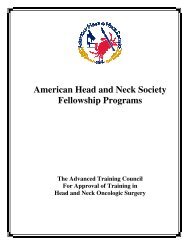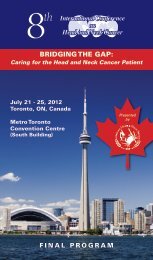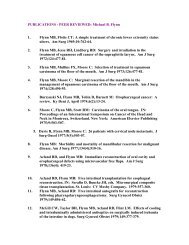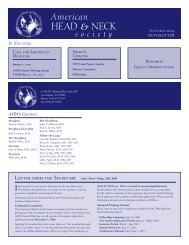Download - American Head and Neck Society
Download - American Head and Neck Society
Download - American Head and Neck Society
You also want an ePaper? Increase the reach of your titles
YUMPU automatically turns print PDFs into web optimized ePapers that Google loves.
Oral Papers<br />
treated off-protocol. Five (38%) of the 13 were NED at last follow-up,<br />
4 (31%) died within one year of completing therapy, 3 (23%) did not<br />
complete therapy <strong>and</strong> died of disease, <strong>and</strong> 1(8%) was lost to follow-up<br />
at 1 year. Older patients with advanced head <strong>and</strong> neck cancer may be<br />
appropriate for clinical trial enrollment, <strong>and</strong> further research in needed<br />
into the barriers to enrollment faced by these patients.<br />
S007<br />
SALVAGE SURGERY AFTER ORGAN PRESERVATION REGIMENS.<br />
Rachel M Brock, MD, Nathan Hales, MD, Greg Krempl, MD, Jesus E<br />
Medina, MD; Oklahoma University Health Sciences Center, Department<br />
of Otorhinolaryngology.<br />
Introduction: Most laryngectomies today are done for persistent or<br />
recurrent tumor after organ preservation attempts using radiation<br />
therapy (RT) or chemotherapy <strong>and</strong> radiation (CRT). The outcomes<br />
reported by RTOG (RTOG-911) for local regional control (LRC), overall<br />
survival (OS) <strong>and</strong> complication rates were encouraging. However recent<br />
publications report abysmal outcomes. Therefore it seems critical to<br />
report outcomes from different institutions in order to better define<br />
the expectations of patients <strong>and</strong> clinicians following salvage surgery.<br />
Furthermore, the role of elective neck dissection (END) in these cases<br />
needs to be defined. Purpose/Objective(s): The purpose of this study<br />
is to determine the rates of LRC, OS, <strong>and</strong> complications with salvage<br />
surgery after previous treatment with radiation +/- chemotherapy <strong>and</strong><br />
also determine the prevalence <strong>and</strong> location of subclinical cervical<br />
lymph node metastases in patients undergoing salvage laryngectomy.<br />
Materials/Methods: Retrospective review of 50 patients who underwent<br />
salvage total laryngectomy (STL) after organ preservation treatment for<br />
laryngeal <strong>and</strong> pharyngeal cancer. 33 patients had definitive RT <strong>and</strong> 17<br />
had CRT. Results: At time of salvage tumor staging was T3 or T4 in<br />
56% of patients in the RT group, 43% in the CRT group. Median time<br />
to recurrence after initial therapy was 11 mos. in both groups. Median<br />
follow-up after STL was 29 mos. in the RT group <strong>and</strong> 20 mos. in the CRT<br />
group. The median OS after salvage in the RT group was 35 mos. (4-<br />
94 mos.) while in the CRT group it was 31 mos. (8-97 mos.). At the last<br />
follow-up OS is 60% after RT <strong>and</strong> 71% after CRT. Median disease free<br />
survival (DFS) is 24 mos. in the RT group <strong>and</strong> 18 mos. in the CRT group.<br />
LRC in the RT group was 58% after RT <strong>and</strong> 76% after CRT. Recurrence<br />
occurred locally in 24% of RT patients <strong>and</strong> 5.8% of CRT patients. <strong>Neck</strong><br />
recurrence most commonly involved II <strong>and</strong> III <strong>and</strong> occurred in 18% <strong>and</strong><br />
11.7% in both groups. Distant metastases occurred in 21% <strong>and</strong> 5.8%<br />
respectively. 47 patients were staged clinically N0 <strong>and</strong> 3 were clinically<br />
N+ at the time of surgery. END was performed with STL in 36 patients.<br />
In these patients, metastases in the lymph nodes were found in 15%<br />
of the RT group <strong>and</strong> in 7% of the CRT group. A pharyngocutaneous<br />
fistula occurred in 21% of patients in the RT group <strong>and</strong> 24% in the CRT<br />
group. Conclusions: The LRC (58 - 76%) <strong>and</strong> OS (60 - 71%) observed<br />
in our study are encouraging. Fistula rates are lower than those reported<br />
in the literature yet they warrant improvement. The presence of occult<br />
metastases (7-15%) is low.<br />
S008<br />
IMPACT OF TIME INTERVAL FROM BIOPSY TO START OF<br />
TREATMENT. Gregory J Kubicek, MD, Seungwon W Kim, MD,<br />
Umanmaheswar Duvvuri, MD, Robert Ferris, MD, Jonas Johnson, MD,<br />
Dwight E Heron, MD FACRO; University of Pittsburgh Medical Center.<br />
Purpose: To investigate the relationship of interval from biopsy to start<br />
of radiotherapy (RT) in head <strong>and</strong> neck cancer (HNC). Patients <strong>and</strong><br />
Methods: 579 consecutive HNC patients treated between 2002 <strong>and</strong><br />
2006 were retrospectively reviewed; all patients received treatment<br />
consisting of either surgery <strong>and</strong> adjuvant RT (249) or definitive RT with<br />
or without chemotherapy (264). RT was IMRT in all patients. Median<br />
age was 63 years, the majority patients were stage III (27%) or IV (51%),<br />
238 (41%) received concomitant chemotherapy. Results: In definitive<br />
RT <strong>and</strong> definitive chemoradiotherapy patients the median time from<br />
biopsy to the start of RT was 41 days. Patients starting definitive RT ≤<br />
40 days from biopsy had an improved outcome versus > 40 days (overall<br />
survival 2.5 vs. 2.1 years p = 0.07). For patients who underwent surgical<br />
resection, median time from biopsy to surgery was 10 days; there was<br />
no difference in outcomes for patients with a longer interval in the time<br />
from biopsy to surgery. Median start to adjuvant RT was 64 days from<br />
the biopsy (54 days from surgery). Patients with a median start time ≤<br />
www.ahns.info<br />
90 from biopsy had an improved overall survival (3.3 versus 2.4 years,<br />
p = 0.015). Conclusion: While the effects of overall treatment time are<br />
well known, less information is available regarding the effects of initiation<br />
of treatment. We found a detriment in overall survival for patients with a<br />
longer interval from the time of biopsy to start of RT.<br />
S009<br />
MANAGEMENT OF EARLY T-STAGE TONSILLAR CARCINOMAS -<br />
RETROSPECTIVE COMPARISON OF RADICAL TONSILLECTOMY<br />
VERSUS RADIATION FROM A SINGLE INSTITUTION. Eric D Lamarre,<br />
MD, Rahul Seth, MD, Robert R Lorenz, MD, Ramon Esclamado, MD,<br />
David J Adelstein, MD, Christina P Rodriguez, MD, Jerrold Saxton, MD,<br />
Joseph Scharpf, MD; Clevel<strong>and</strong> Clinic.<br />
Objective: T1 <strong>and</strong> T2 squamous cell carcinomas of the tonsil can<br />
be managed with either definitive radiation therapy or a radical<br />
tonsillectomy, which involves en bloc resection of the tonsil, underlying<br />
superior constrictor, partial base of tongue, soft palate <strong>and</strong> pharynx<br />
with or without reconstruction of the defect. We report a retrospective<br />
comparison of the Clevel<strong>and</strong> Clinic survival <strong>and</strong> functional outcomes<br />
using both of these approaches. Method: All patients diagnosed with<br />
T1-2, N0-2, M0 squamous cell carcinoma of the tonsil <strong>and</strong> treated at<br />
the Clevel<strong>and</strong> Clinic between 1994 until 2007 were included in this<br />
review. The minimum follow-up for survival was 2 years, <strong>and</strong> patients<br />
with a second primary upper aerodigestive cancer were not included<br />
in the functional data. Swallowing was graded on a scale of 1-4 with 1<br />
being a normal diet <strong>and</strong> 4 being feeding tube dependence. Results:<br />
There were 27 patients treated surgically <strong>and</strong> 84 patients treated with<br />
radiation. For the surgical patients, 74% of patients were staged as T1,<br />
33% of patients N2, 30% N1 <strong>and</strong> 37% N0. For the radiation patients,<br />
71% of patients were staged as T2, 61% of patients N2, 20% N1 <strong>and</strong><br />
19% N0. 48% of the surgical patients also had postoperative radiation<br />
<strong>and</strong> 15% had concurrent chemotherapy secondary to extent of neck<br />
disease. 61% of the radiation patients had concurrent chemotherapy<br />
<strong>and</strong> 25% had staged neck dissections. The 2 year disease free survival<br />
was 85.7% for the surgical patients <strong>and</strong> 83.9% for the radiation patients<br />
(p=0.44). Within the first two months after completion of therapy,<br />
72% of surgical patients had grade 1 swallowing versus 18.9% of<br />
radiation group (p








